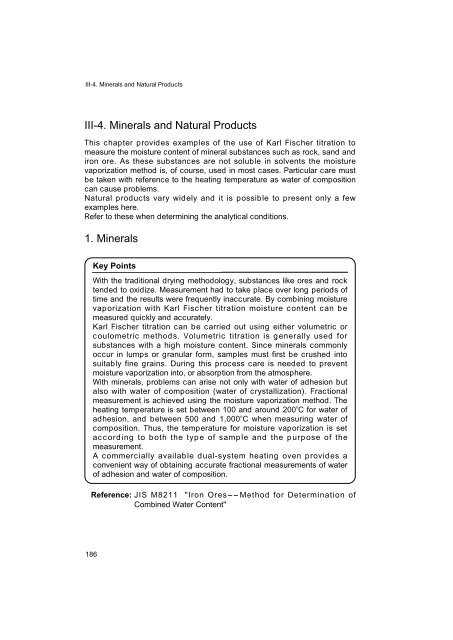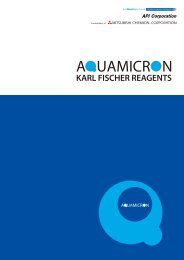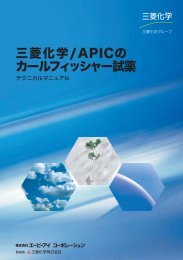Development of Karl Fischer Reagents
Development of Karl Fischer Reagents
Development of Karl Fischer Reagents
Create successful ePaper yourself
Turn your PDF publications into a flip-book with our unique Google optimized e-Paper software.
III-4. Minerals and Natural Products<br />
III-4. Minerals and Natural Products<br />
This chapter provides examples <strong>of</strong> the use <strong>of</strong> <strong>Karl</strong> <strong>Fischer</strong> titration to<br />
measure the moisture content <strong>of</strong> mineral substances such as rock, sand and<br />
iron ore. As these substances are not soluble in solvents the moisture<br />
vaporization method is, <strong>of</strong> course, used in most cases. Particular care must<br />
be taken with reference to the heating temperature as water <strong>of</strong> composition<br />
can cause problems.<br />
Natural products vary widely and it is possible to present only a few<br />
examples here.<br />
Refer to these when determining the analytical conditions.<br />
1. Minerals<br />
With the traditional drying methodology, substances like ores and rock<br />
tended to oxidize. Measurement had to take place over long periods <strong>of</strong><br />
time and the results were frequently inaccurate. By combining moisture<br />
vaporization with <strong>Karl</strong> <strong>Fischer</strong> titration moisture content can be<br />
measured quickly and accurately.<br />
<strong>Karl</strong> <strong>Fischer</strong> titration can be carried out using either volumetric or<br />
coulometric methods. Volumetric titration is generally used for<br />
substances with a high moisture content. Since minerals commonly<br />
occur in lumps or granular form, samples must first be crushed into<br />
suitably fine grains. During this process care is needed to prevent<br />
moisture vaporization into, or absorption from the atmosphere.<br />
With minerals, problems can arise not only with water <strong>of</strong> adhesion but<br />
also with water <strong>of</strong> composition (water <strong>of</strong> crystallization). Fractional<br />
measurement is achieved using the moisture vaporization method. The<br />
heating temperature is set between 100 and around 200 � C for water <strong>of</strong><br />
adhesion, and between 500 and 1,000 � C when measuring water <strong>of</strong><br />
composition. Thus, the temperature for moisture vaporization is set<br />
according to both the type <strong>of</strong> sample and the purpose <strong>of</strong> the<br />
measurement.<br />
A commercially available dual-system heating oven provides a<br />
convenient way <strong>of</strong> obtaining accurate fractional measurements <strong>of</strong> water<br />
<strong>of</strong> adhesion and water <strong>of</strong> composition.<br />
186<br />
Key Points<br />
Reference: JIS M8211 "Iron Ores--Method for Determination <strong>of</strong><br />
Combined Water Content"




